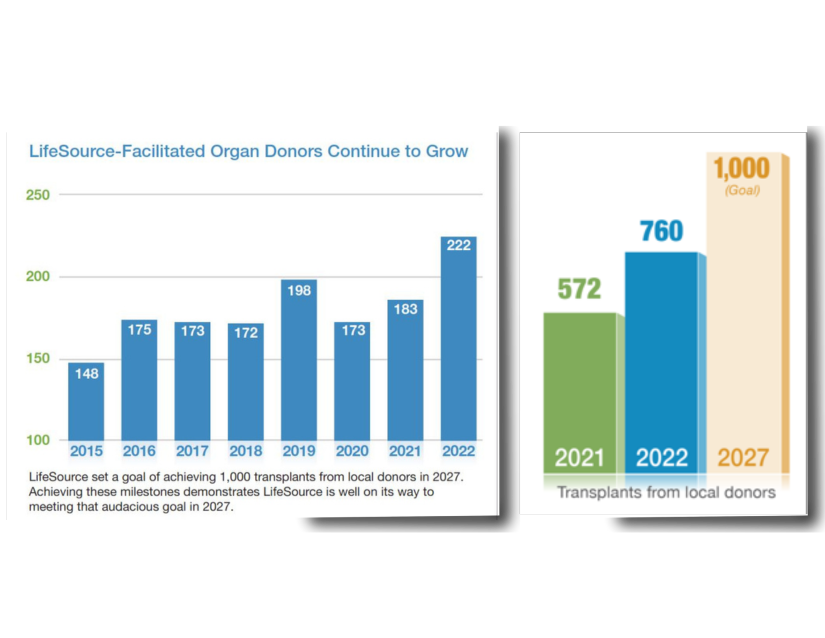Relentlessly Focusing to Save More Lives
In December 2019, The Centers for Medicaid & Medicare Services (CMS) issued new performance metrics for organ procurement organizations (OPOs), like LifeSource. The intent is to assess performance and drive improvement.

LifeSource has embraced the evaluation measures and is working to ensure we yield positive benefits for donors and recipients, who are the heart and soul of LifeSource and the mission we serve.
On Friday, April 28, CMS released a report on OPO performance during 2021 (18-month lag in reporting), and LifeSource is in Tier 3 along with nearly half of the OPOs in the country – 42% of OPOs are in Tier 3.
Our Plan to Reach Tier 1
We’ve carefully examined our data and, based on our analysis in conjunction with the major steps we are taking to further our mission on behalf of donors and their families, LifeSource feels confident we have the right strategies to put us in Tier 1 and achieve our ultimate goal of saving more lives.
2022 was a record year for LifeSource with more organ donors and organs transplanted than any other year. We expect to be solidly in Tier 2 for 2022 (report will be released in 2024) and to continue this upward trajectory based on the plans outlined below.

Specific Initiatives Currently Underway
Addressing transportation/access issues
- New transportation logistics partner: LifeSource has the second largest service area in the United States layered with weather challenges that can impede recovery and transplant operations. For example, we had a driver in late December 2022 go to great lengths to deliver a kidney from a hospital in one state to a transplant center in another – all during a snowstorm that shut down all air travel in the region. KSTP covered the story. LifeSource contracted with a new transportation logistics company in late 2022, Trinity Medical, to work us to coordinate flights and provide vehicles for transport recovery teams, surgeons and organs; the snowstorm story above involved one of Trinity’s drivers.
- Drones: We are exploring innovative transportation solutions as longer-term strategies; including drone transportation. A test flight was first completed in 2021.
Operating room (OR) availability/organ utilization
- Establishing Donor Care Units (DCUs): These involve moving a donor out of the hospital critical care unit into a dedicated facility. This process has shown to have benefits for donor hospitals, donor families, transplant teams and OPO operations. Conducting donor management and organ recovery in a centralized facility promotes quality and consistency throughout the donation process. Transplant surgical teams also can schedule OR times. LifeSource is the process of establishing two DCUs at major hospitals in Minnesota (to be announced) – both by the end of 2023.
- Hiring dedicated recovery surgeon(s): LifeSource previously relied on the availability of local transplant hospital surgeons if a recipient’s surgeon does not fly/travel to complete the recovery. Having dedicated staff surgeons will increase authorization rates for families who would otherwise decline due to timing. One, potentially two, will be hired by Q3 of 2023.
Increasing community participation
- Organ donation is different from any other area of health care; it asks individuals and families of potentials donors to give organs as an altruistic gift; the entire process is not possible without them saying “yes”. Right now, 56% of people in our service area are registered. Here is the map of registration (DVS provides this data to us monthly). Also, when approached at the hospital, communities of color in Minnesota say yes at rates 30 percent lower than whites. Earning their trust and support for this process takes deep and ongoing community engagement.
- Hiring Equity, Diversity and Inclusion (EDI) director: In 2021, LifeSource hired an EDI director to apply an equity lens to everything we do from our clinical operations to our internal hiring practices. Our goal is for LifeSource staff to represent the racial diversity of our community by 2025. Ensuring representation inside our organization will best position us to serve the community. In 2022, 15 percent of our team members were people of color compared to 9 percent in 2019. In 2022, 22% of organ donors LifeSource cared for were people of color.
- Continuing our work with communities of color: This work includes expanding our previous “Barbershop Conversations” program and, in 2022, LifeSource was the first organization in the country to partner with a Native American tribe to add donor designation to a tribal ID. Here’s an Associated Press story on the initiative. We are establishing relationships with Twin Cities-based tribes to provide gain trust and discuss barriers.
Organ donation is a highly collaborative process – it truly takes all of us. Thank you for your support in our work to save more lives. If you’re interested in advocating and sharing information about the importance of registering to be an organ donor, please reach out to info@life-source.org.
 Skip to main content
Skip to main content
